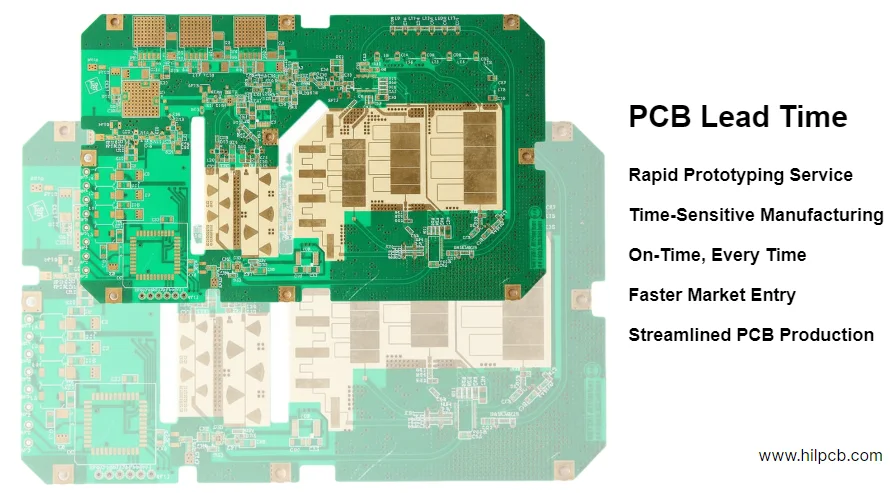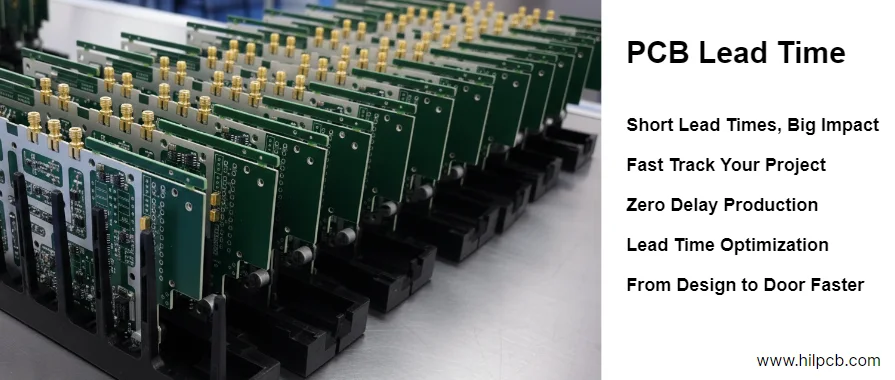Fast and predictable PCB lead time is essential to keep development cycles on schedule and maintain competitiveness. Every extra day in production increases costs, delays product launches, and ties up working capital.
This guide explains the full PCB manufacturing timeline, the factors that influence it, and proven methods to reduce turnaround time without compromising reliability or cost efficiency.
For material cost analysis and pricing structure insights, see PCB cost.
1. Understanding the Complete PCB Production Timeline
A typical PCB production timeline involves several stages—engineering validation, material sourcing, fabrication, testing, and shipping.
Optimizing each of these phases can shorten total lead time significantly.
Engineering Review (1–2 days)
Manufacturers verify Gerber files, layer stackups, and design rules during this phase. Clear, complete documentation avoids back-and-forth communication delays.
Material Procurement (0–10 days)
Standard FR4 materials are usually in stock, but high-frequency laminates (Rogers, Taconic) or thick copper often require supplier lead time. For PCB assembly, component sourcing can become the bottleneck.
Fabrication (1–7 days)
Production time depends on board complexity:
- 2-layer PCBs: 24–48 hours
- 4-layer: 3–5 days
- 6-layer or more: up to 7 days
Surface finish and testing add another 1–2 days.
Post-Production and Delivery (1–7 days)
Packaging, labeling, and PCB delivery preparation take about one day.
Domestic express shipments take 2–5 days, while international air freight averages 5–7 days.

2. Key Factors That Influence PCB Lead Time
Lead time varies according to design complexity, manufacturing requirements, and file preparation.
Design and Layer Count
The more layers and tighter design tolerances, the longer the build time.
Boards with blind/buried vias, fine-pitch traces, or impedance control may require sequential lamination and extra inspection.
Material Availability
Exotic substrates or heavy copper often add days to procurement. Aligning your sourcing strategy with manufacturing schedules reduces waiting periods.
File Completeness
Missing fabrication notes or drill data are common causes of production delay. Clean, well-structured files can shorten the engineering phase by several days.
Manufacturing Specifications
Special finishes, via types, or microvias require dedicated processes. When possible, use standard configurations to streamline fabrication and testing.
3. When to Choose Rush Services
Quick-turn PCB services can deliver boards in as little as 24–72 hours—but at a cost premium of 30–50%.
They are worthwhile for:
- Prototype validation where time-to-market matters
- Emergency replacements for production equipment
- Critical R&D projects with short iteration cycles
However, frequent use of expedited manufacturing quickly increases PCB pricing and overall annual costs.
Standard lead times, combined with accurate planning and communication, usually achieve the same quality at significantly lower prices.

4. Practical Strategies to Shorten PCB Production Time
Reducing PCB lead time is about precision planning and collaboration, not just paying for faster services.
Plan in Volumes, Not in Batches
Consolidating small, frequent orders into scheduled production runs minimizes setup time and improves queue management.
Pre-Stock Materials and Components
Communicate forecasts early so your supplier can pre-purchase key substrates and components. Aligning procurement with PCB sourcing avoids waiting on material deliveries.
Standardize Design Rules
Using consistent stackups, drill sizes, and materials across projects reduces engineering setup time and allows reusing existing tooling.
Build Long-Term Supplier Partnerships
Reliable manufacturers provide scheduling flexibility and transparent communication. Strengthening relationships also stabilizes your PCB supply chain.
Manage Inventory Intelligently
Keep a small buffer of critical boards in stock. Integrated PCB inventory planning helps prevent emergency rush orders.
5. Frequently Asked Questions About PCB Lead Time
What is PCB lead time?
PCB lead time is the total duration from placing your order to receiving finished boards. It includes design review, material procurement, fabrication, and delivery. Typical production runs take 7–14 days, while express orders can finish in as little as 1–3 days.
What affects PCB production speed the most?
Design complexity, material availability, and order volume are the main drivers. Simple two-layer PCBs build faster, while multilayer or HDI designs require additional processing time.
How can I make PCB manufacturing faster?
Provide clean, complete design files and use standard materials. Plan orders ahead, communicate forecasted volumes, and choose reliable suppliers who maintain adequate stock and capacity.
Are quick-turn PCB services worth the price?
Yes, when fast development cycles matter more than cost—especially during prototyping or urgent replacements. But for large-scale production, standard lead times with better planning offer greater savings.
Does shipping time count as part of lead time?
Yes. Lead time includes manufacturing and PCB delivery to your location. Domestic shipping usually adds 2–5 days; international air freight can take up to 7 days.
How do I avoid production delays?
Confirm your manufacturer’s material availability, finalize design files before ordering, and use standard specifications. Strong communication with your vendor prevents most timeline disruptions.
Conclusion
Efficient PCB lead time management depends on more than just fabrication speed—it’s about integrating design, procurement, and logistics planning into a single coordinated workflow. Companies that plan strategically, communicate proactively, and standardize their processes consistently achieve shorter, more predictable turnaround times—without paying rush premiums.
At HILPCB, we streamline every stage from PCB design review to component sourcing and production scheduling to ensure your boards arrive on time, every time. Whether you’re prototyping or scaling to volume production, our agile manufacturing system and in-house logistics network help you reduce lead time without compromising quality.

